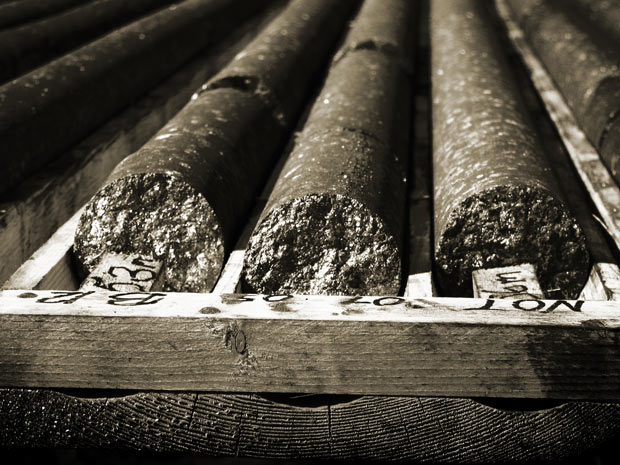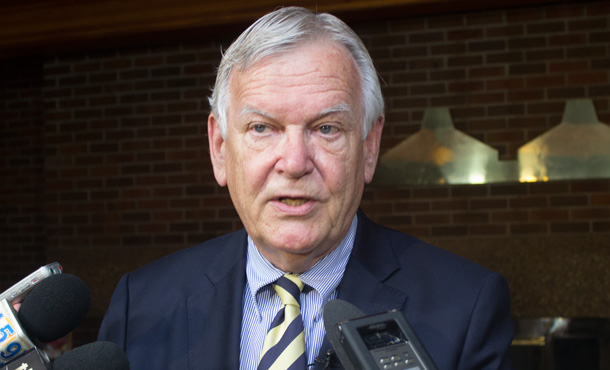 THUNDER BAY – Politics – Minister of Northern Development and Mines Michael Gravelle was the guest of the Thunder Bay Chamber of Commerce on Friday. The Minister was addressing the business audience on the efforts of his Ministry in the economic development in the province.
THUNDER BAY – Politics – Minister of Northern Development and Mines Michael Gravelle was the guest of the Thunder Bay Chamber of Commerce on Friday. The Minister was addressing the business audience on the efforts of his Ministry in the economic development in the province.
Here is the text of the Minister’s remarks:
Articulating a Vision for a Prosperous North
and a
Strong Provincial Mineral Development Sector
Good afternoon, everyone. It’s wonderful to be here to speak with so many members and guests of the Chamber of Commerce. Thank you for being here.
As I said just after the new Ontario government was formed, I’m honoured that Premier Wynne has entrusted me with the portfolio of Northern Development and Mines.
I’m excited to be back in a role where I can combine my strong commitment to northern communities with my understanding of the issues and opportunities, gained from direct connection with many, many northerners during my years as an MPP and, most recently, as Minister of Natural Resources.
For that reason it’s important to me, as I begin my second term as Northern Development and Mines Minister, for my first formal speaking engagement to be here with you.
Let me start by thanking the Chamber for accommodating my request, and for organizing this opportunity for us to get together.
Today I want to speak about my own vision for how we get the North and the province’s minerals sector to where they need to be, how I see my priorities being backed up by the new Ontario government, and what I see as your role in this noble cause.
During my years as an MPP and then Cabinet minister, I’ve given a lot of thought to the idea of a champion.
By that I mean someone who takes extraordinary interest in the adoption, implementation and success of a cause or project… a person who will steer an idea through what can sometimes be entrenched, internal resistance to change…someone who will promote that idea throughout the organization.
And while the word “champion” has never appeared in my job description, I have certainly considered it a standard to strive for.
I think of that often these days, as our region – and all of Northern Ontario – is faced with tremendous, exciting opportunities for mineral resource development, as well as for broader economic development, both related to mining and in other areas.
As we know, such opportunities — like the Ring of Fire, which is top of mind for so many northern communities and businesses these days — bring with them challenges.
The more far-reaching the possible benefits and consequences, the more considered must be the preparation, planning and development.
…And the more all parties need to engage in respectful conversation so that the ideas and projects we’re championing are worthy, and that we can achieve them in a way that makes sense, and balances a range of interests.
As you know, last Friday the new Ontario government held its inaugural Cabinet ministers’ meeting in the North, as Premier Wynne had said we would.
Meeting in the Sault was a way to emphasize this government’s commitment to addressing the specific interests of northern communities… a way to acknowledge that the government’s focus on new jobs and strong communities is indeed province wide.
It was a clear acknowledgement that Northern Ontario is a key part of the province’s economy.
As an aside, I can tell you that it was great timing for a Cabinet meeting in the North: the concerns of many northern communities were already fresh in the minds of the ministers who had met with delegations at ROMA/OGRA. And while we were in the Sault, various groups had the opportunity to reinforce local issues during meetings with ministers.
As you know, my problem-solving style is to meet face-to-face whenever possible… to listen… and to look for common ground upon which to build solutions.
I’m encouraged by the emphasis that this government will continue to put on development of a strong northern economy and the continued prominence of Ontario’s minerals sector.
For example, within days of taking office, the Premier committed to creating a northern cabinet committee. And during last week’s cabinet meeting, that committee was put together.
Bill Mauro will chair this committee made up of 14 MPPs and ministers from all over the province. These include myself and ministers of key portfolios like Transportation, Infrastructure, Energy, Aboriginal Affairs, Natural Resources, Economic Development & Trade, among others.
The result will be that the North’s interests come to be shared and more deeply understood by MPPs, some of whom live in southern Ontario and may have limited knowledge about our circumstances. We want more of Ontario’s legislators to fully appreciate the enormous contributions that a strong northern economy and a strong minerals sector make to the province.
My own expectation and hope is that this committee will go a long way toward bridging the province’s perceived north/south solitudes.
I don’t have to describe you the ways in which my ministry acts to advance the North’s economy and the province’s minerals sector:
- You’re well acquainted with programs like the Northern Highways Program and the Northern Ontario Heritage Fund.
- Many of you here have been involved in the process to modernize the Mining Act, and you’re knowledgeable about new Mining Act regulations.
- You’ve actively participated in the development of the Growth Plan for Northern Ontario.
So instead, let me tell you how I intend to use those programs as tools to help build a stronger northern economy.
Let’s start with the Growth Plan
I feel strongly about the Growth Plan’s ability to guide the process of creating a new, globally competitive region. I’m glad to say that this process is already well underway.
For example, last August, I was delighted to take part in the announcement about the establishment of the Northern Policy Institute. I had worked on the first stages of this project in early 2011, and I was gratified to see it get off the ground.
Last month the institute’s board of directors met in the Sault for its first meeting. They selected a Chair, who is Martin Bayer from Sudbury, and Vice Chair, who is George Macey from Marathon.
I’m sure you noted, as I did, that half of the 10-member board is from Northwestern Ontario.
Like many of you and many other northerners who advocated for a body like the NPI, I anticipate that it will effectively provide a northern perspective for provincial policies and programs that affect Northern Ontario, and for monitoring the implementation of the Growth Plan.
Under the umbrella of the Growth Plan, I see my ministry advancing economic development and northern prosperity via several key priorities.
One of those priorities is, of course, the minerals sector.
Earlier this week, I was at the PDAC, the Prospectors and Developers Association of Canada’s annual convention.
I can tell you that Premier Wynne, who spoke at the opening of the Ontario Pavilion and welcomed the mining world to explore what our province has to offer, was extremely impressed by the scope of activities at the convention.
I, for my part, was very pleased that the Premier attended to get a first-hand sense of the drive and energy and importance of this industry.
I can also tell you that, during the PDAC, Premier Wynne, Aboriginal Affairs Minister David Zimmer and I sat down with Matawa Chiefs for an historic meeting. We talked about such issues as social, community and economic development supports; resource revenue sharing and long-term monitoring of the regional environment.
This was my fifth PDAC, so I knew that, once again, Ontario would be the focus of intense international attention. And no wonder. We’re blessed with incredible mineral wealth.
In addition, we offer excellent programs and services that support mineral developers… for example, the province’s Northern Industrial Electricity Rate Program, which helps mining companies as well as forestry and steel companies in the North to remain competitive and compete globally.
Our investment climate ranks among the world’s best.
And our government is committed to building sustainability in the sector.
You’ve heard the numbers: the value of Ontario’s mineral production in 2012 was $9.2 billion. With 41 mines currently operating in the province, Ontario is producing 23 per cent of the nation’s minerals, more than any other province.
Reports indicate that global demand for the minerals we produce will only increase. We are working to ensure that Ontario is well-positioned to meet that demand.
One of the ways we’re ensuring that Ontario’s minerals sector remains one of the best places in the world for mineral exploration and mining investment is by modernizing the Mining Act.
Since last November when we introduced Phase 2 regulations, industry clients have been voluntarily submitting applications for early exploration plans and permits. Ministry staff have already issued some permits, and some plans are now in effect. I know that staff have been working through the regulatory process with industry to make the process work for both sides, and that this is an ongoing priority.
Currently, we’re reminding clients that as of April 1, the requirement for plans and permits will be mandatory for both new and ongoing exploration projects.
These days, we can’t talk about mineral exploration and development in Ontario without talking about the Ring of Fire.
It was a hot topic at the PDAC, with good reason.
We know that mineral developments in the Ring of Fire have the potential to generate significant numbers of new jobs and social benefits.
And we know that there’s a lot to be done to realize the economic potential of mineral deposits in the Ring of Fire.
For our part, the government is committed to the environmental assessment and regulatory approvals processes. We’re committed to addressing our duty to consult, and to seeing the Ring of Fire developed in a sustainable manner that produces the best results for Ontario.
At the PDAC, I met with my federal counterpart on the Ring of Fire, Minister Tony Clement. It was great to have the feds finally come to the table.
We had a frank discussion about how our governments need to work together with industry, First Nations and stakeholders to realize the economic potential of mineral deposits in the Ring of Fire.
We agreed that with the Ring of Fire knocking, we need to open the door to this tremendous opportunity.
Of course, there’s more to mining in Ontario than the Ring of Fire.
And if it sometimes seems that mining is all about the future, look at the progress we’re making right now.
Our government said it would help the mining industry in opening at least eight new mines in 10 years. Here’s how that’s going:
- Three mines started commercial production last year.
- Three more mining operations are expected to reach commercial production this year.
- And at least two more mines are expected to come on stream in 2014.
Here in the Northwest, North American Palladium Ltd. continues progress on its major expansion of the Lac des Iles Mine. In Red Lake, Goldcorp is advancing its projects, and expects the Cochenour Mine to produce its first gold in 2015.
This bodes well for the future of the industry in Ontario. It holds the promise for economic development and job creation, especially in Northern Ontario.
And just as mining in Ontario is more than the Ring of Fire, economic development in Northern Ontario is more than mining.
I realize that in my enthusiasm, I’ve just about used up my time. If you’ll bear with me for a bit longer, I’d like to make two more points before I wrap things up.
I referred a few minutes ago to the NOHFC and the Northern Highways Program.
In the case of the NOHFC, the government’s 2012 Budget provided an unprecedented $100 million to the NOHFC to invest in new projects across the North to stimulate growth, attract investment and create jobs in a diverse economy.
The Heritage Fund is a well-used, still-sharp tool that this government and preceding ones have used to good effect for the past 25 years.
I intend, as Chair of the NOHFC, to ensure that we keep a close eye on programs so that they match the priorities of northern communities, businesses and individuals. And that we tailor the programs, when needed, to get the best fit.
In the case of the Northern Highways Program, our investments have been critical in helping spur economic development, improve safety and enhance the quality of life for northerners.
For example, the government has completed Highway 11 expansion in the Northeast south of North Bay. We’re continuing with expansion work on Highway 69 south of Sudbury and on Highway 11/17 east of Thunder Bay.
As you may have heard, the tender call went out this week for the Nipigon River bridge project. We’re all eager to see that exciting project get underway.
Everyone in this room understands that well planned and well maintained transportation infrastructure is absolutely fundamental to northern prosperity.
The good news these days is that we’re being backed up in this by a re-energized Ontario government. In the Throne Speech and in subsequent interviews, Premier Wynne has stated that a sustainable pan-northern transportation system is needed to develop the North and our vast mineral potential.
This commitment by the new government ties in very well with the Growth Plan’s call for a long-term multimodal transportation strategy to integrate planning of all modes of transportation in Northern Ontario: air, rail, marine and road. And this government has responded, with the Ministry of Transportation now well underway on its Northern Multi-Modal Transportation Strategy.
The pan-northern transportation strategy is one of the initiatives of the Growth Plan that the new Northern Cabinet committee will be monitoring, to ensure people and goods across the North can get where they need to go. It’s also a matter which, I am sure, the Northern Policy Institute will consider as part of its work.
We can look at the Growth Plan as the overarching strategic framework to guide decision making and investment planning for the future long-term prosperity of Northern Ontario. It includes priorities in the minerals and transportation sectors, as well as for other economic development opportunities. The basic foundation for all of these priorities is the government’s need to consult northern leaders – including Aboriginal leaders.
When it comes to development of the North, the government recognizes the unique role of Aboriginal peoples.
Our government is committed to respecting Aboriginal rights and to meeting our duty to consult Aboriginal peoples.
We will continue to work closely with Aboriginal communities and organizations, industry, stakeholders and other levels of government to ensure that Aboriginal communities benefit from natural resource development.
As the Premier has said, Ontario will continue to work with Aboriginal communities to ensure they “have access to the tools and training they need to fully participate in economic development opportunities, including those related to natural resources.”
The government relies on the knowledge of all northern leaders, whether they be municipal, Aboriginal or from industry and academia.
We rely on your knowledge to help guide us. We need you to help us make the best decisions in support of strong communities, new jobs and healthy, engaged northerners.
You know me. You know that I believe and have said that we’re all in this together. I’m so pleased that my government echoes this view.
When I was sworn in as minister last month, I publicly reaffirmed my commitment to advance the North’s interests and the province’s minerals sector… to — in effect — champion these priorities.
I’m eager to continue this work, which needs the combined efforts of all of us who live in and care about the North.
I look forward to working with the broad spectrum of municipalities and First Nations and Métis communities, stakeholders, partners, organizations and individuals, to deliver on our government’s vision for a prosperous Northern Ontario and a strong provincial minerals sector.
Thank you.
Michael Gravelle MPP
Minister of Northern Development and Mines






